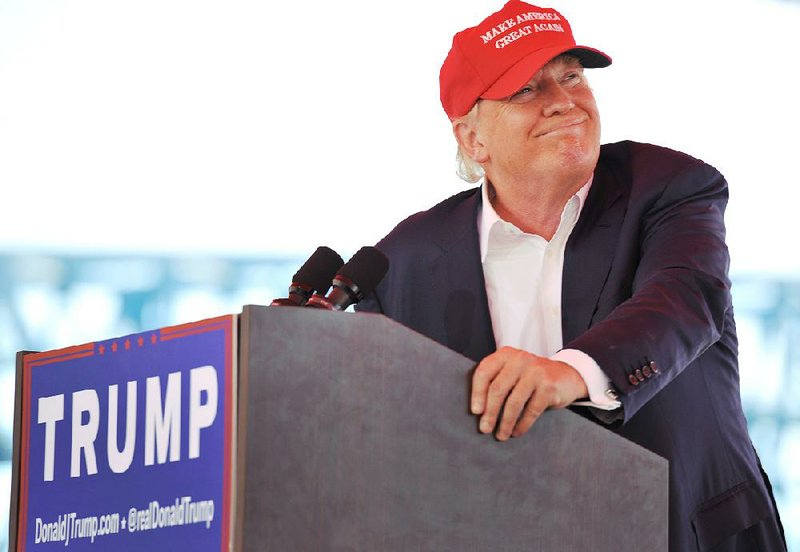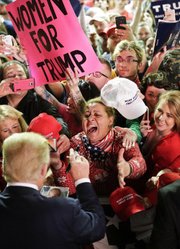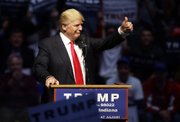For most of the Republican Party primary season, my predictions were wrong. At the beginning I thought Wisconsin Gov. Scott Walker or Florida Sen. Marco Rubio would likely be the nominee. When Donald Trump picked fights with Fox News and claimed Arizona Sen. John McCain wasn't a war hero because he was captured, I thought it would damage Trump's standing in the polls. When Texas Sen. Ted Cruz won Iowa I thought media coverage might substantially shift away from Trump. I could go on.
For a long time I predicted someone other than Trump would surely win the nomination. Most other data-driven journalists and analysts were Trump-skeptical for most of the GOP nomination contest. So how and why did those of us in the world of political data, whose predictions have been so successful in recent presidential elections, miss the boat on Trump? I've put together a list of some of the errors we made this primary. Hopefully examining these mistakes will help us better understand future nominating contests and what might lay ahead in the 2016 general election.
• In the early stages of the Trump campaign, the data world explained Trump's polling lead by citing his disproportionate share of media coverage. There was something to this, but the idea was incomplete.
Our theory was simple. Everyday Americans lead busy lives, and in the early stages of a primary (summer 2015), they aren't paying much attention to presidential politics. So if a pollster calls and asks for their opinion, they'll probably talk about whomever they saw on the news last (which was probably Trump). This same effect contributed to the short-lived prominence of Herman Cain and then-Texas Gov. Rick Perry in 2012.
This theory wasn't entirely wrong. Before Trump got in, former Florida Gov. Jeb Bush had high name recognition, got most of the media attention and held a small lead in the polls. But unlike Bush and the boom-and-bust candidates of 2012, Trump used his media dominance to consolidate a faction within the GOP. Culturally traditional but not especially religious Republicans who had less education and lower incomes than their co-partisans flocked to Trump. His positions on trade
and immigration, along with his brash persona and his spirited flouting of "political correctness," cemented their loyalty. The political world didn't catch on to this at first, and that's why so many of us expected his bubble to burst when negative press coverage hit. This led us to underestimate Trump and misunderstand his appeal for much longer than we should have.
• Political analysts seem to have relied too heavily on The Party Decides, a 2008 book by four political scientists who argue that party actors--those most actively involved in politics from senators and governors down to volunteer door-knockers--tend to informally rally around an ideologically mainstream (within the party) candidate before the first vote is cast. They then use their influence, money and power to persuade voters to give the nomination to that candidate. Trump, who appeared neither electable nor orthodox, was anathema to these party actors, so many analysts thought the party would veto his candidacy and lift someone else to the nomination.
This year the theory fell flat on its face. No candidate had the party behind him heading into Iowa. The party elite attempted to rally around Rubio in February and March, but the voters disagreed. Rubio was beaten roundly on Super Tuesday and dropped out after losing his home state on March 15.
There are several reasons the theory failed: party actors don't wield much influence anymore, the theory only works when there's a clear front-runner, or Trump is a once-in-a-lifetime phenomenon. Or maybe there was never enough data to be confident about this theory in the first place. After all, the modern primary system--a long string of state-by-state votes where candidates earn delegates to the national convention--has been around for 44 years. Presidential elections happen every four years, and many primaries are uncontested (sitting presidents often don't draw serious challengers), which adds up to only 16 primaries. So in the future we might want to approach other theories of primaries with an appropriate amount of skepticism.
• Primaries often boil down to a race between two candidates relatively quickly. Candidates who don't gain traction often get tired, run out of money, and decide to go back to their day jobs. But we underestimated how long it would take the field to winnow and how much the dropouts' slow pace would help Trump.
Five candidates--Trump, Rubio, Cruz, John Kasich and Ben Carson--were still around in March. Cruz, Rubio, Kasich, and Carson shared the non-Trump vote, which let Trump grab many delegates. Kasich, who was fourth in a three-man race for almost two months (he lagged behind Rubio in delegates long after Rubio quit), also stayed in past his expiration date. This made it harder for Cruz to say he was the only non-Trump candidate.
These candidates (and most of data journalism) were operating under the theory that Trump would lose a one-on-one matchup with a mainstream Republican. Exit polling and public polling seemed to bolster the idea. Trump, despite repeated wins and being the best-known candidate, hovered around 35 to 40 percent of the popular vote for most of the primary season. Then he out-performed projections in New York and the subsequent Northeastern primaries. Analysts like me were slow to realize that his over-performance in New York was the new normal. And while Cruz had won a functionally one-on-one contest against Trump in Wisconsin in early April, he lost a similar contest in Indiana in May, effectively ending the race.
• A lot of political and economic theory rests on the idea that people are rational. But the GOP elite showed this assumption doesn't always hold in the real world, which partially explains why predictions that the "Elites Will Stop Trump" didn't pan out.
At pivotal moments in this campaign, GOP donors, other presidential campaigns, or conservative media outlets might have identified and pursued a more effective strategy to stop Trump. But they didn't, raising the question of whether they acted irrationally. One example: contributors to Jeb Bush.
Various GOP money men who presumably didn't want to see Trump nominated donated about $150 million to Bush or a Bush-affiliated super PAC. This did not turn out to be money well spent. Bush was out of practice--he flubbed a predictable question about the Iraq War (a conflict launched by his brother). When Trump called him "Low Energy Jeb," he didn't respond effectively. But the bigger problem is that Jeb Bush's policies on issues ranging from immigration to trade were out of step with a critical mass of the GOP.
The harbinger was the defeat--also in a Republican primary--of House Speaker-in-waiting Eric Cantor, who lost his seat to an underfunded populist who portrayed Cantor as a tool of big banks and a squish on illegal immigration.
Many of Bush's backers either failed to anticipate these problems or anticipated some of them and donated anyway. These donors were far from the only Republican elites who made strategic miscalculations. Many kept their powder dry for too long, and others assumed Trump would go away naturally. But political movers and shakers are fallible. Many misread the electorate's mood. Whether they had the power to stop Trump, they didn't always pursue the most effective strategies.
• Primaries also bear some resemblance to what are known as "chaotic systems" in math.
Chaotic systems behave according to defined rules, and sometimes you can predict what the system will do in the near future. But longer-term predictions are by nature difficult. Primaries to some degree have this feature. For example, in January it was possible with some certainty to predict that Trump would win the New Hampshire primary. He was leading in the polls and the state was demographically favorable. But it would have been much harder back then to predict that he would win Indiana, much less the nomination.
No math model, for instance, could predict how effectively New Jersey Gov. Chris Christie would skewer Rubio in the debate heading into New Hampshire.
Such interactions can have huge consequences. And I didn't fully take into account that chaos and uncertainty when I made my projections.
Chaotic systems are also sensitive to changes in initial conditions. If you feed the same system two slightly different starting points, the system might end up in a pretty different place. If Trump had never run, maybe Rubio and Cruz would still be fighting it out. If Bush passed on the race and a more effective candidate was the recipient of the establishment's financial largesse, maybe he or she would have become the consensus anti-Trump candidate. For that matter, if Trump had started off with a better ground game he would have won Iowa, bulldozed the rest of the calendar, and become the nominee six weeks earlier.
The point is that primaries are weird and hard to predict. And not recognizing their chaotic nature can lead analysts like me to have unwarranted levels of certainty in our predictions. That seems to be what happened with Trump.
David Byler is an elections analyst for RealClearPolitics.
Editorial on 05/22/2016


